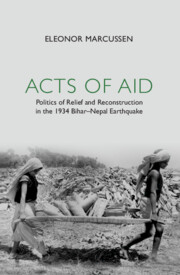Book contents
- Frontmatter
- Contents
- List of Illustrations
- List of Tables
- Acknowledgements
- List of Abbreviations
- Note on Transliteration
- 1 Introduction: Experiencing the Extraordinary and the Ordinary
- 2 Responses and Responsibilities in Emergency Relief
- 3 From Local to National Politics of Relief
- 4 Colonial Relations in Aid
- 5 Categories of Victims
- 6 Congested and Contested Spaces
- 7 Conclusion
- Glossary
- Bibliography
- Index
7 - Conclusion
Published online by Cambridge University Press: 13 January 2023
- Frontmatter
- Contents
- List of Illustrations
- List of Tables
- Acknowledgements
- List of Abbreviations
- Note on Transliteration
- 1 Introduction: Experiencing the Extraordinary and the Ordinary
- 2 Responses and Responsibilities in Emergency Relief
- 3 From Local to National Politics of Relief
- 4 Colonial Relations in Aid
- 5 Categories of Victims
- 6 Congested and Contested Spaces
- 7 Conclusion
- Glossary
- Bibliography
- Index
Summary
One of the larger aims of this book is to examine the earthquake as a sociopolitical process in its historical context. While doing so, I have discussed how experiences with past disasters and the contemporary sociopolitical setting affected responses in the aftermath. The very disruptive nature of an earthquake, literally throwing people off their feet, crumbling buildings and destroying lives and livelihoods, makes the event into a process of change experienced by communities and individuals on a psychological and physical level. Whether viewed as an opportunity for change or an unwanted agent of destruction, or both, the devastation wrought by the earthquake led to a set of responses that can enhance our understanding of vulnerability and resilience.
Throughout the chapters of this book, the relationships between various disaster responses, that is, the approaches of the government, civil society actors and victims are at the centre of analysis. A disaster calls into question who cares, and for whom. The diversity of needs, the invisibility and the visibility of neglected and prioritised relief receivers respectively, tell us about the unequal effect disaster have on people, not just in the long or short aftermath but also for historians relying on archival sources. Greg Clancey suggests that disaster victims ‘may be the ultimate historical subalterns’. In the case of the dead, the victims’ voices are complicated to recover as a group, whether in a historical or contemporary disaster. Yet the dead are often instrumentalised in, for instance, disaster reconstruction where they become evidence of needful changes in construction improvements or settlement patterns. In the more recent past, the perception of the disaster body as the ultimate subaltern historical subject resonates with Henry A. Giroux’s reflections on the body politics of the dead in the aftermath of the hurricane Katrina. Giroux argues that the invisibility of bodies post-Katrina was the effect of a ‘politics of disposability’. The bodies rendered invisible were not simply the outcome of failed governance and a natural hazard. According to Giroux, the government’s disaster policy in Katrina rendered ‘disposable’ lives invisible by editing out bodies, death and human suffering and focusing on material destruction. His analysis places racism at the core of how citizens were negated protection, access to relief provisions, media attention and sympathy.
- Type
- Chapter
- Information
- Acts of AidPolitics of Relief and Reconstruction in the 1934 Bihar–Nepal Earthquake, pp. 302 - 317Publisher: Cambridge University PressPrint publication year: 2023
- Creative Commons
- This content is Open Access and distributed under the terms of the Creative Commons Attribution licence CC-BY-NC 4.0 https://creativecommons.org/cclicenses/



